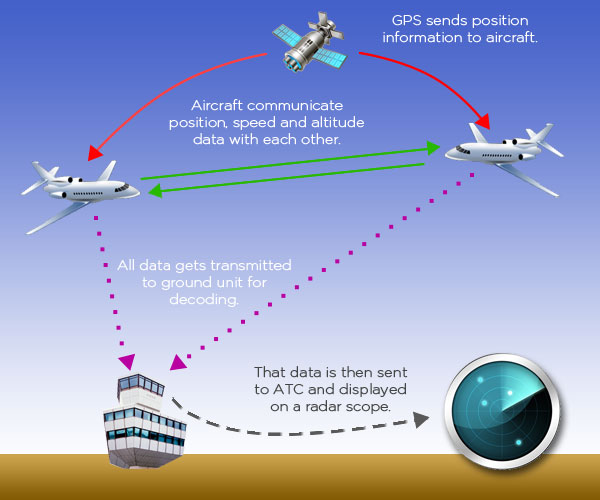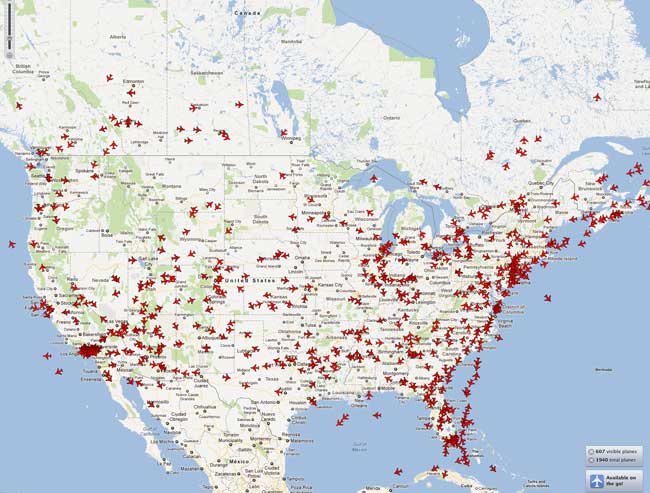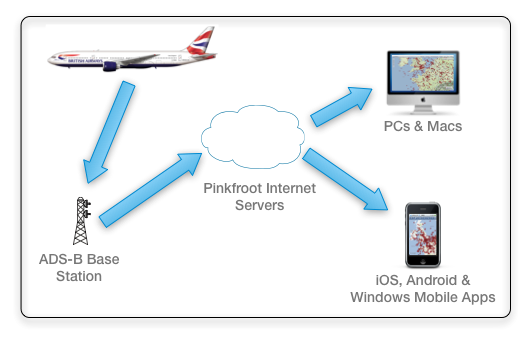Tüm Ülkelerdeki Uçakların Şuan Bulunduğu Yeri, Geldiği Rota, Bilgileri Canlı olarak görebileceğiniz Bir Harita
How PlaneFinder works
Plane Finder works by picking up ADS-B plane feeds used by commercial and private planes to transmit their name, position, callsign, status and lots more.
Our servers add additional information such as departure airport, destination and photos for presentation on planefinder.net and in our Plane Finder apps.
The ADS-B data comes to us either from our own receivers or from people with receivers who share their data with us over the internet. If you are a virtual radar hobbyist we’ll be delighted to receive your data for use within the app. For more details on how you can help please see our coverage page.
ADS-B is gradually replacing radar as the most efficient method for air traffic control.
Ultimately ADS-B will enable aircraft to fly closer together and on more efficient routes meaning less fuel consumption and reduced flight times. ADS-B will also enable advanced transfer of information both to and from the cockpit.
In locations such as Europe and Australia the implementation is well advanced and the majority of aircraft use ADS-B. North America is behind currently but will catch up as the US NextGen ADS-B equipage project continues to develop.
Plane Finder is showing a slow but steady increase in planes tracked as ADS-B use continues to grow.
We know that this website and the apps are used by a huge range of people including professionals such pilots and ground crew, by plane spotters and aviation enthusiasts, and by anyone who just wants to track a friend or is curious about the planes overhead.
We hope that you enjoy Plane Finder however you use it!
A more detailed explanation of ADS-B is provided below:

ADS-B (Automatic Dependant Surveillance Broadcast System) is a technology used for aircraft surveillance. Currently, air traffic control relies on the use of ground based radar systems. ADS-B will change this to a satellite based tracking system eradicating known issues and unreliability’s with standard radar tracking.
Currently being rolled out worldwide, ADS-B is part of the Next Generation Air Transportation System also called “NextGen”.
i –
Next Generation Air Transportation System (NextGen)
To be introduced in the US between 2012 and 2025 NextGen will change the way in which American air traffic control works. It will move from being a ground based system using traditional surveillance radar to a ground/satellite system. This will enable route shortening, reduced traffic delays and increased fuel and time efficiency.
ADS-B greatly enhances the safety of air travel by providing not only air traffic control with real time, consistent and visible position updates but also other aircraft equipped with ADS-B. This will enable aircraft to effectively ‘see’ each other during flight.
Relying on two avionics components ADS-B uses:
- High integrity GPS unit
- Data link unit (operating at 1090 MHz – modified Mode S transponder)
i – What is Mode S?
All aircraft carry units within their avionics system called transponders (transmitter and responder). These transponders, at the most basic level, emit a four digit signal that can be controlled via a panel on the instrument panel.
 These four digits are assigned by air traffic control. On the radar screen the controller can see the four digit code alongside the radar return of the aircraft. This enables them to identify the aircraft. The signal is received and ‘interrogates’ the transponder. That number is then returned and known as a ‘Squawk’.
These four digits are assigned by air traffic control. On the radar screen the controller can see the four digit code alongside the radar return of the aircraft. This enables them to identify the aircraft. The signal is received and ‘interrogates’ the transponder. That number is then returned and known as a ‘Squawk’.
Short for ‘selective’ mode, Mode S transponders allow more information to be sent when the air traffic control radar interrogates the transponder. It sends information on altitude, callsign and squawk code which also enables the Airborne Collision Avoidance System (ACAS) and ADS-B systems to function.
How does ADS-B work?
Simply put, ADS-B uses the avionics within an aircraft to communicate with GPS satellites in orbit and transmit data about:
ADS-B OUT – Data from the aircraft
- Callsign
- Altitude
- Heading
- Position
- Squawk number
- Speed
ADS-B IN – Data into the aircraft
- Weather – via Flight Information Service-Broadcast (FIS-B)
- Terrain
- Information – via Traffic Information Service-Broadcast (TIS-B)
- Traffic
This data is then received and decoded by other aircraft equipped with ADS-B avionics and ground receivers. These ground receivers then display this information to air traffic controllers through a display. From this information they can provide vectoring instructions and organize the skies with more accuracy and more reliable information. Additionally, other aircraft equipped appropriately can also see the same information providing them with a very good early warning system enhancing their own situational awareness.
The Benefits of ADS-B
The ADS-B system makes flying drastically safer predominantly by allowing surrounding aircraft to be able to see other aircraft as well as several other benefits:
- Safety – ADS-B will make flying significantly safer.. When using this system both pilots and controllers see the same radar picture.
- Management – The accurate data enables better decision making by ATC and pilots. This in turn will lead to savings in journey time and fuel.
Both IFR (Instrument Flight Rules) and VFR (Visual Flight Rules) flights benefit from the system giving:
- Increased safety with controlled separation in non-radar airspace
- More accurate and readily available information can be provided to VFR flights
Some of the biggest benefits will be to the Air Traffic Control Officers that manage the aircraft flying within controlled airspace are:
- Increased efficiency of traffic flow
- Merging and spacing information
- Increased level of information
- More consistent level of radar returns
- Alleviates some pressure by allowing improved in-cockpit information to pilots
In addition ADS-B data can also be received in-bound (ADS-B IN) by suitable equipped aircraft. This will provide additional resources to the pilot including:
- Weather – Through information broadcasts, aircraft can receive weather reports, through Flight Information Service-Broadcast (FIS-B), providing more information to the pilot about surrounding weather.
- Terrain – The system also provides pilots with a terrain overlay, again increasing safety.
- Information – ADS-B also allows aircraft and their pilots to receive NOTAMs (Notice To AirMen) and TFRs (Temporary Flight Restrictions) via Traffic Information Service-Broadcast (TIS-B).
- Traffic – ADS-B will allow the pilot to view information on surrounding aircraft. This includes callsign, altitude, heading, speed, and distances.
Why is it important to Planefinder?
ADS-B technology is important to Planefinder, because along with other radar technologies it enables us to track aircraft live through our app and provide up to date, accurate and reliable information on aircraft flying around the world.
The more aircraft and airlines that adopt ADS-B the more aircraft we can track and show through the app. All the aircraft that are displayed on Planefinder are aircraft equipped and using ADS-B technology. Although an on-going process, but the FAA predict that 90% of aircraft in the US will be equipped with ADS-B by 2018. As ADS-B becomes more prolific, businesses operating within the aviation industry will invest in it. This will lead to more and more aircraft will become available for tracking through Planefinder. This includes aircraft within commercial based flight and general aviation.

You can help!
You can help increase PlaneFinder’s radar coverage by either sharing your data with us via your home virtual radar. Whatever system you own you can easily share your data with us and help to increase the level of coverage. Simply follow the instructions on Planefinder.net to begin sharing your ADS-B tracking information.
Not based in the UK? Great, we’re always looking to increase Planefinder’s reach worldwide. Wherever you are we’re interesting in hearing about what data you can share with us. Read more about home ADS-B radar receivers and ask others questions by getting involved with our plane enthusiast community on Pinkfroot.
Planefinder.net
The Planefinder.net website has been implemented in partnership with Something Interesting Limited.
Something Interesting are a professional and passionate development team focused on delivering quality projects. The team like to enjoy what they do, speak like humans and have their client’s best interests at heart. They don’t believe in cutting corners and won’t compromise the quality of their work.
